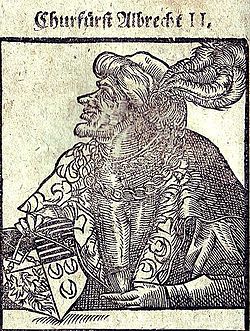Albert II, Duke of Saxony
| Albert II Albrecht II. von Sachsen, Engern und Westfalen (de) |
|
|---|---|
|
officially: Duke of Saxony, Angria and Westphalia colloquially: Duke of Saxe-Wittenberg |
|

Woodcut by Balthasar Mencius (Menz), 1596, showing Albert II holding the Saxon coat-of-arms. Inscription: Churfürst Albrecht II. (trl. Prince-Elector Albert II)
|
|
|
Duchy of Saxony (joint rule with his elder brother John I until 1282 and then with the latter's sons Eric I, John II, and Albert III) |
|
| Joint Reign | 1260–1296 |
| Predecessor | Albert I, Duke of Saxony |
| Successor | Albert II (ruling alone in partitioned Saxe-Wittenberg) |
|
Duchy of Saxe-Wittenberg (Albert II and his nephews divided their common duchy in 1296) |
|
| Reign | 1296–1298 |
| Predecessors | Albert II and his nephews Albert III, Eric I and John II (joint rule) |
| Successor | Rudolf I, Duke of Saxe-Wittenberg |
| Born | 1250 Wittenberg upon Elbe |
| Died | 25 August 1298 near Aken |
| Burial | Wittenberg upon Elbe |
| Saxon Consort | Agnes of Habsburg |
| Issue Detail |
Rudolf I Otto Anna (*?–1327*) Elisabeth (*?–1341*) Venceslaus (*?–1327*) Albert, Prince-Bishop of Passau |
| House of | Ascania (by birth) |
| Father | Albert I, Duke of Saxony |
| Mother | Helen of Brunswick and Lunenburg |
| Religion | Roman Catholic |
Albert II of Saxony (Wittenberg upon Elbe, ca. 1250 – 25 August 1298, near Aken) was a son of Duke Albert I of Saxony and his third wife Helen of Brunswick and Lunenburg, a daughter of Otto the Child. He supported Rudolph I of Germany at his election as Roman king and became his son-in-law. After the death of their father Albert I in 1260 Albert II jointly ruled the Duchy of Saxony with his elder brother John I, and thereafter with the latter's sons.
In 1269, 1272 and 1282 the brothers gradually divided their governing competences within the three territorially unconnected Saxon areas (one called Land of Hadeln around Otterndorf, another around Lauenburg upon Elbe and the third around Wittenberg), thus preparing a partition.
In the imperial election in 1273 Albert II represented the jointly ruling brothers. In return Rudolph I had married his daughter Agnes of Habsburg to Albert II. After John I had resigned in 1282 in favour of his three minor sons Eric I, John II and Albert III, followed by his death three years later, the three brothers and their uncle Albert II continued the joint rule in Saxony.
In 1288 Albert II applied to King Rudolph I for the enfeoffment of his son and heir Duke Rudolf I with the Electorate of Saxony, which ensued a long lasting dispute with the eager clan of the House of Wettin. When the County of Brehna was reverted to the Empire after the extinction of its comital family the king enfeoffed Duke Rudolf. In 1290 Albert II gained the County of Brehna and in 1295 the County of Gommern for Saxony. King Wenceslaus II of Bohemia succeeded in bringing Albert II in favour of electing Adolf of Germany as new emperor: Albert II signed an elector pact on 29 November 1291 that he would vote the same as Wenceslaus. On 27 April 1292 Albert II, with his nephews still minor, wielded the Saxon electoral vote, electing Adolf of Germany.
...
Wikipedia
